Hailing from Sicily, this lasagna bread, also known as Scaccia Ragusana, is layered with sauce, cheese, herbs and even eggplant. We’re in love with it and you will be too.
In the Sicilian hilltop town of Ragusa, among the Baroque buildings, churches, and other UNESCO World Heritage landmarks, one of the highlights of any visit is a ubiquitous street food known as scaccia.
Scaccia is perhaps best described as a cross between a calzone and lasagna—a stuffed bread full of thin layers of dough. When scaccia emerges from the oven, the outermost layer is completely crispy, nicely browned, and charred in spots, yet the inner layers have a tender, noodle-like texture to them from the absorption of moisture from the tomato sauce and cheese. So, you get the best of both worlds, the crispy (and, according to some, the best) parts of lasagna and the al dente-ness of properly cooked pasta (hence the term “lasagna bread”).
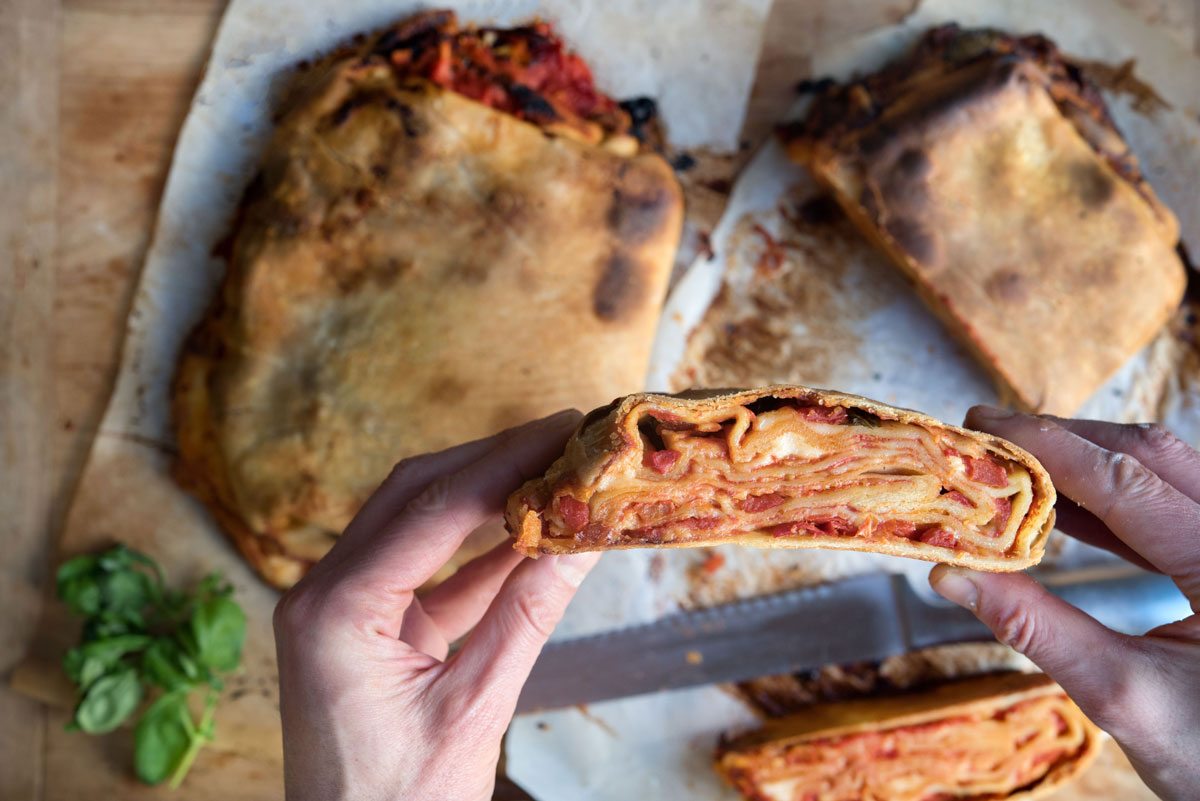
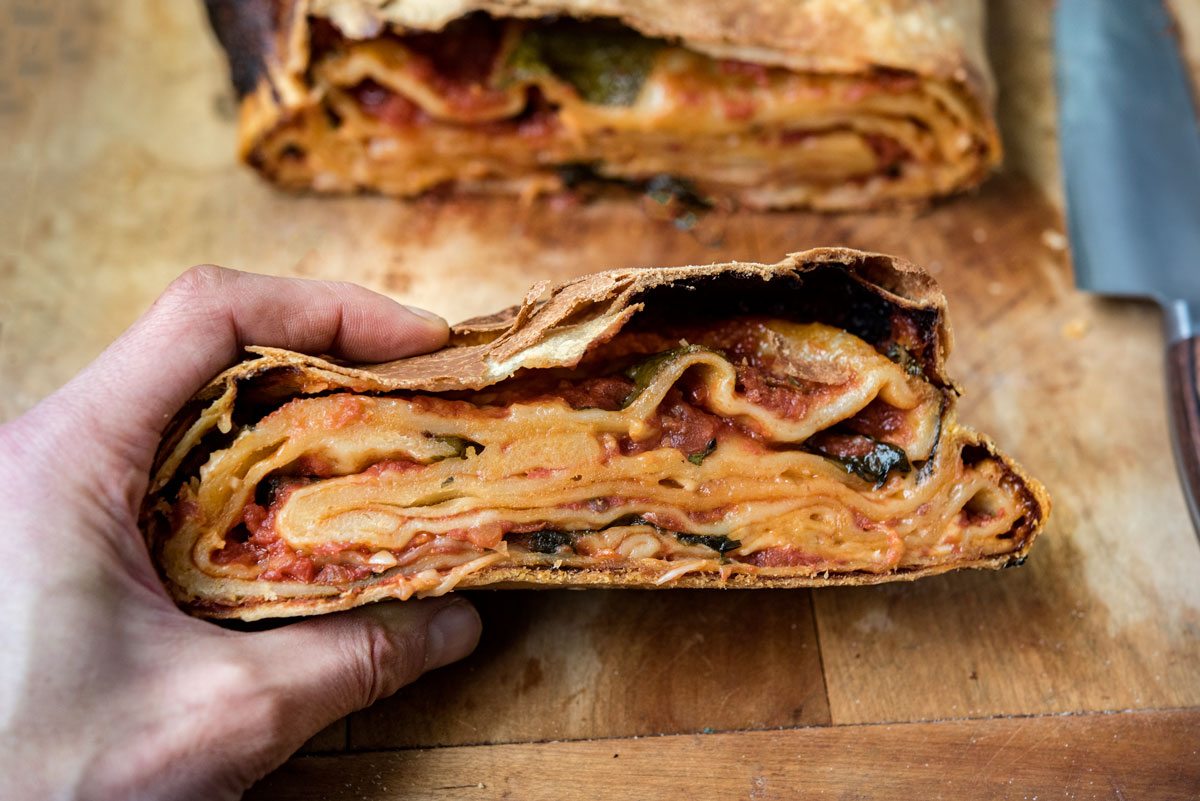
The noodle-like consistency comes as the result of the combination of durum semolina and water. I’ve come across recipes for scaccia that substitute 00 flour, a type of soft wheat with a high protein/gluten content, for some of the semolina.
As with many Italian dishes and many street foods, scaccia has an inherent rusticity to it. The beauty of this is that when you’re rolling out the dough, you don’t have to be overly concerned if it’s not the perfect shape or size. You want the layers fairly thin, and from there it’s just a matter of layering the fillings, folding, and repeating.
When choosing a filling, your options are endless. Typical fillings range from a straightforward combination of tomato sauce, garlic, basil, and cheese to fresh ricotta with onions, sausage, tomatoes. My favorite (so far) is pan-fried eggplant with fresh ricotta, grated Parmesan, and basil. The flavors remind me of an eggplant Parmesan, but instead of breaded eggplant, the eggplant is encased in layers of “noodles.”
As for baking, a pizza/baking stone is ideal, as it retains heat and, to an extent, mimics a wood-burning oven. A stone absorbs and radiates intense heat to create a flavorful, crispy crust.
No matter how it looks when it comes out of the oven, your Lasagna Bread will be a delicious carb fest. It’s best eaten hot out of the oven.
I like my Lasagna Bread on the saucy side, so I scaled up the amount of sauce. Any leftover sauce is ideal for dunking the scaccia. I divided the dough in half and made one version with tomato, basil and cheese, and a second version with tomato, pan-fried eggplant, fresh ricotta, grated Parmesan, and basil. Use this as a guide, but definitely feel free to swap in your favorite fillings.
How to Make Scaccia Ragusana – Sicilian Lasagna Bread
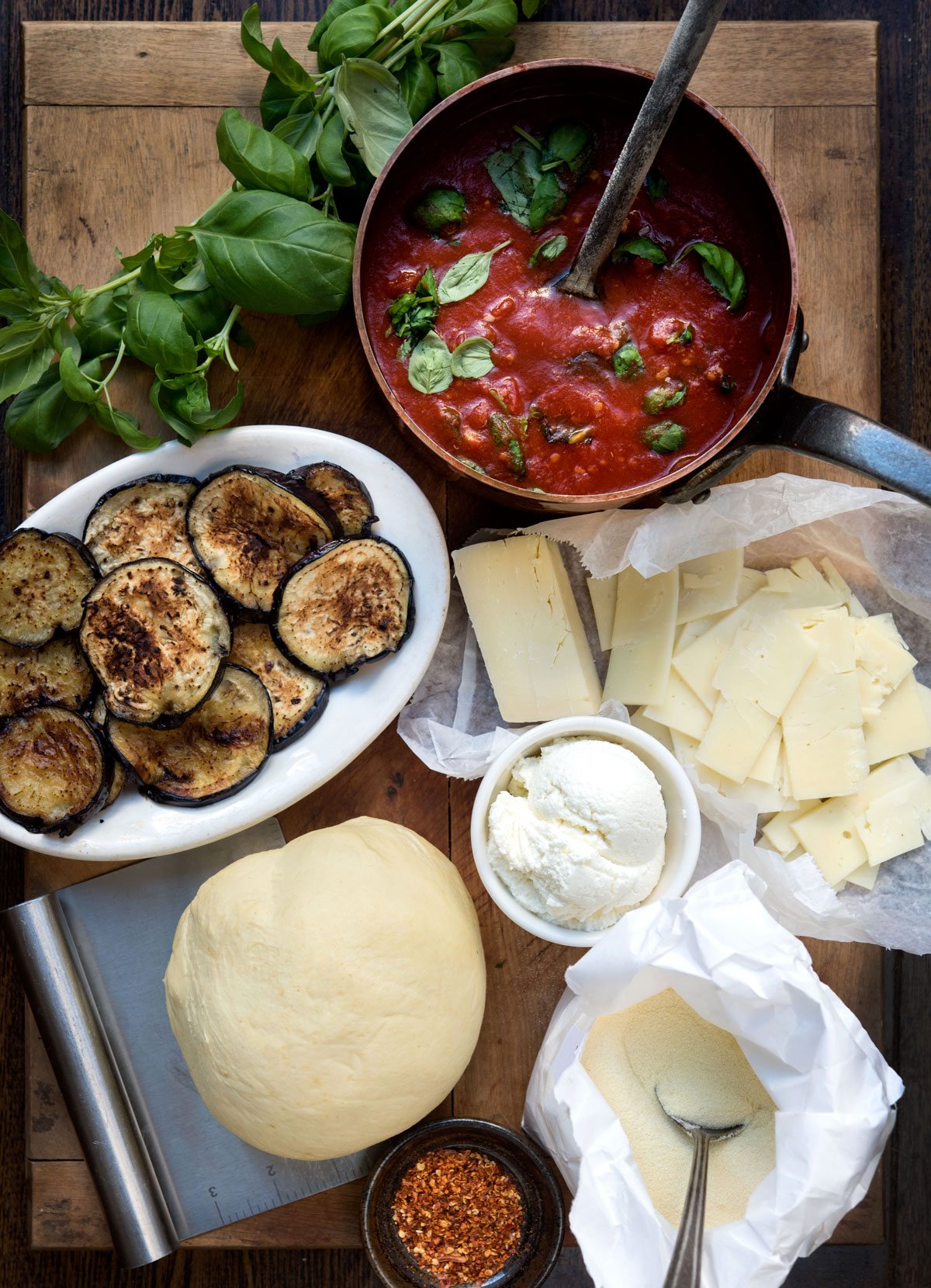
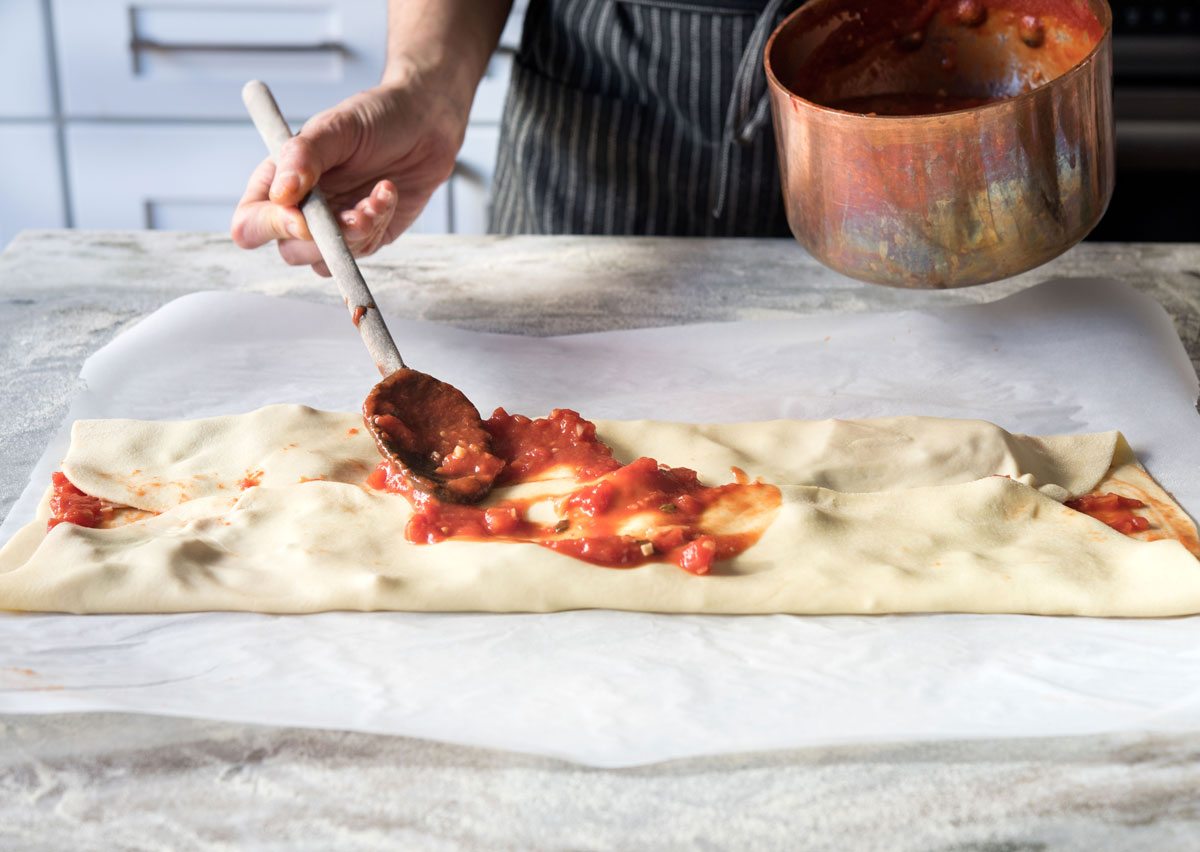
Prepare the Tomato Sauce:
- Heat 1 tbsp olive oil in a saucepan over medium heat.
- Add the anchovies, breaking them up with a wooden spoon until dissolved.
- Stir in the minced garlic and a pinch of red pepper flakes, sautéing for about 1 minute.
- Add the crushed tomatoes, season with salt, and toss in a handful of torn basil leaves.
- Bring the mixture to a boil, reduce the heat, and simmer for 10-15 minutes until the sauce thickens. Taste and adjust seasoning as needed.
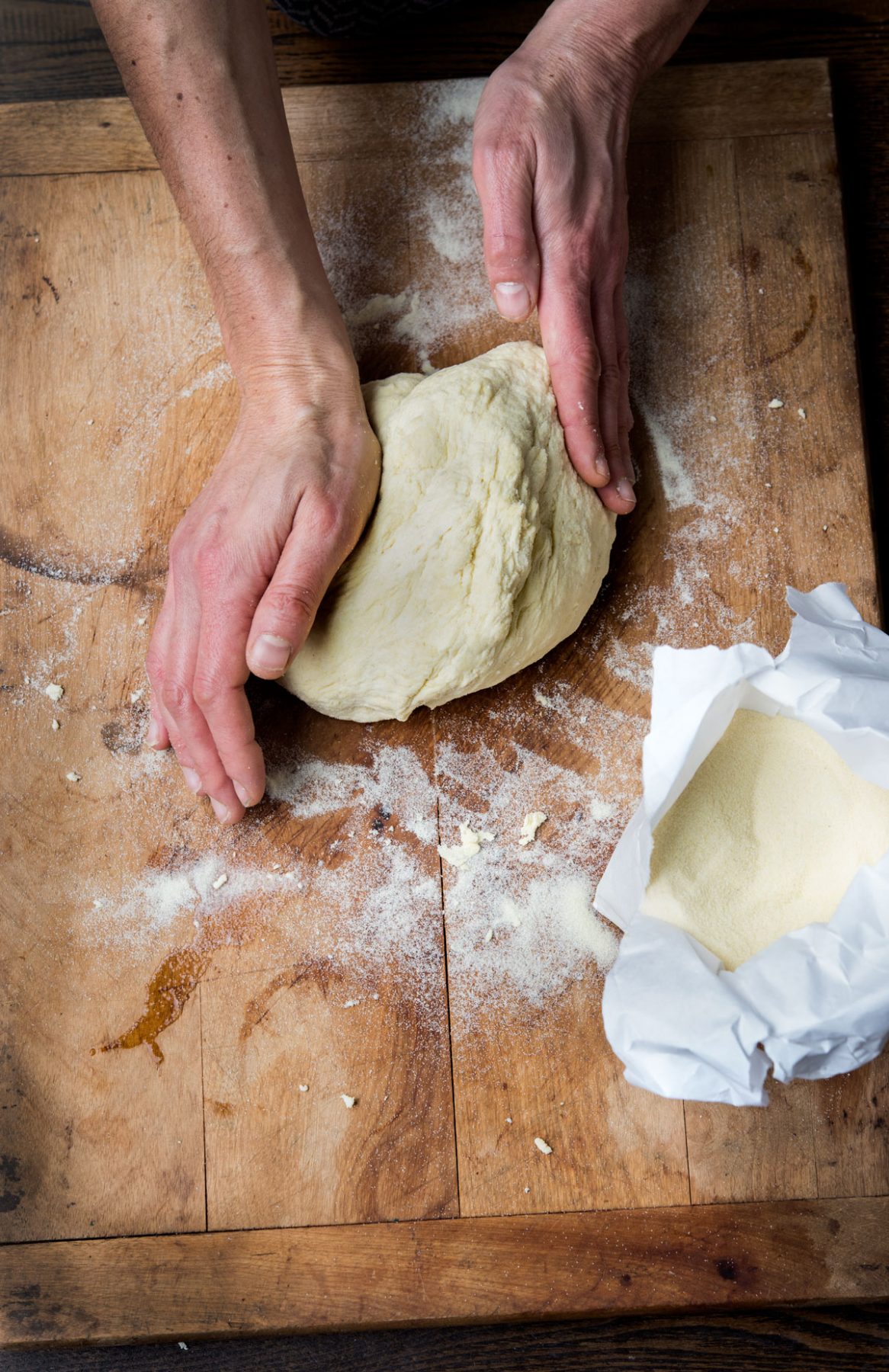
Make the Dough:
- In a large bowl, combine the semolina flour and salt.
- Drizzle in 2 tbsp olive oil, then slowly mix in the water.
- Knead the dough on a floured surface for 5-7 minutes until smooth and elastic.
- Cover with plastic wrap and let rest for 30 minutes.
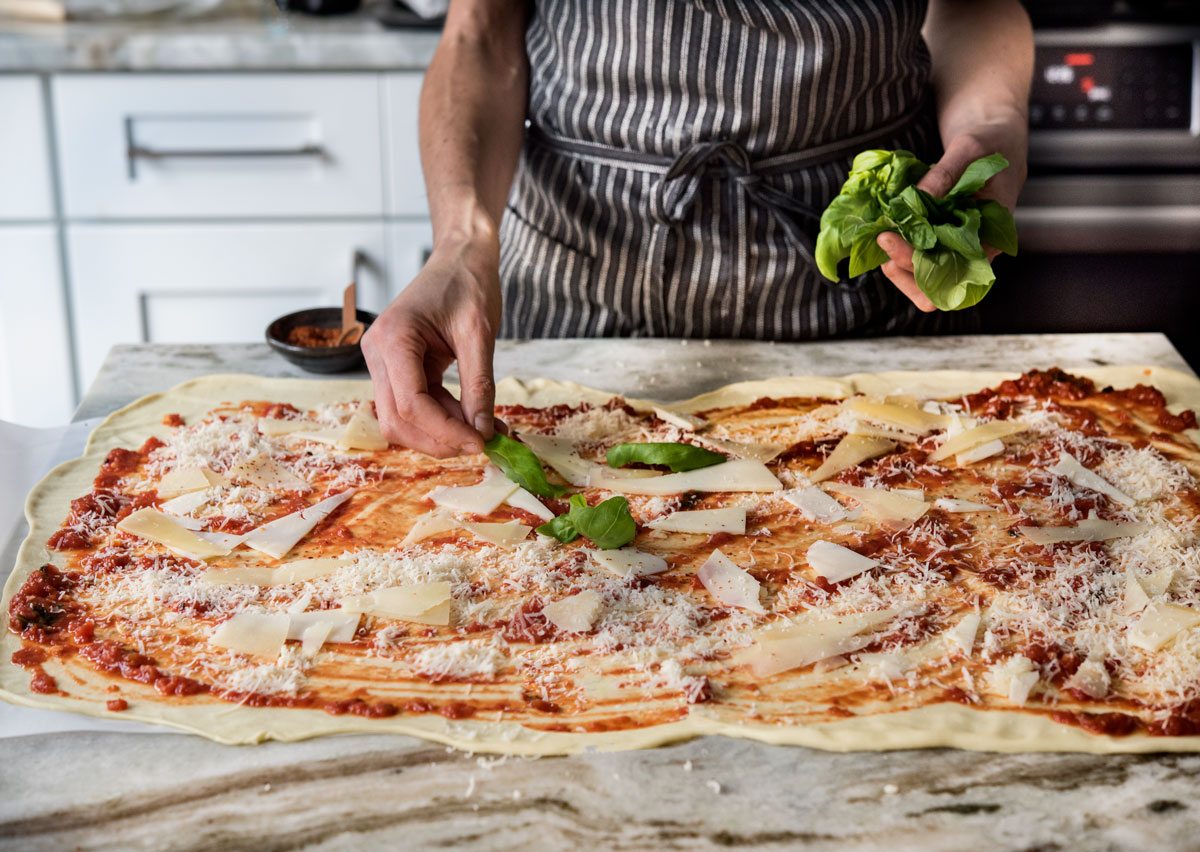
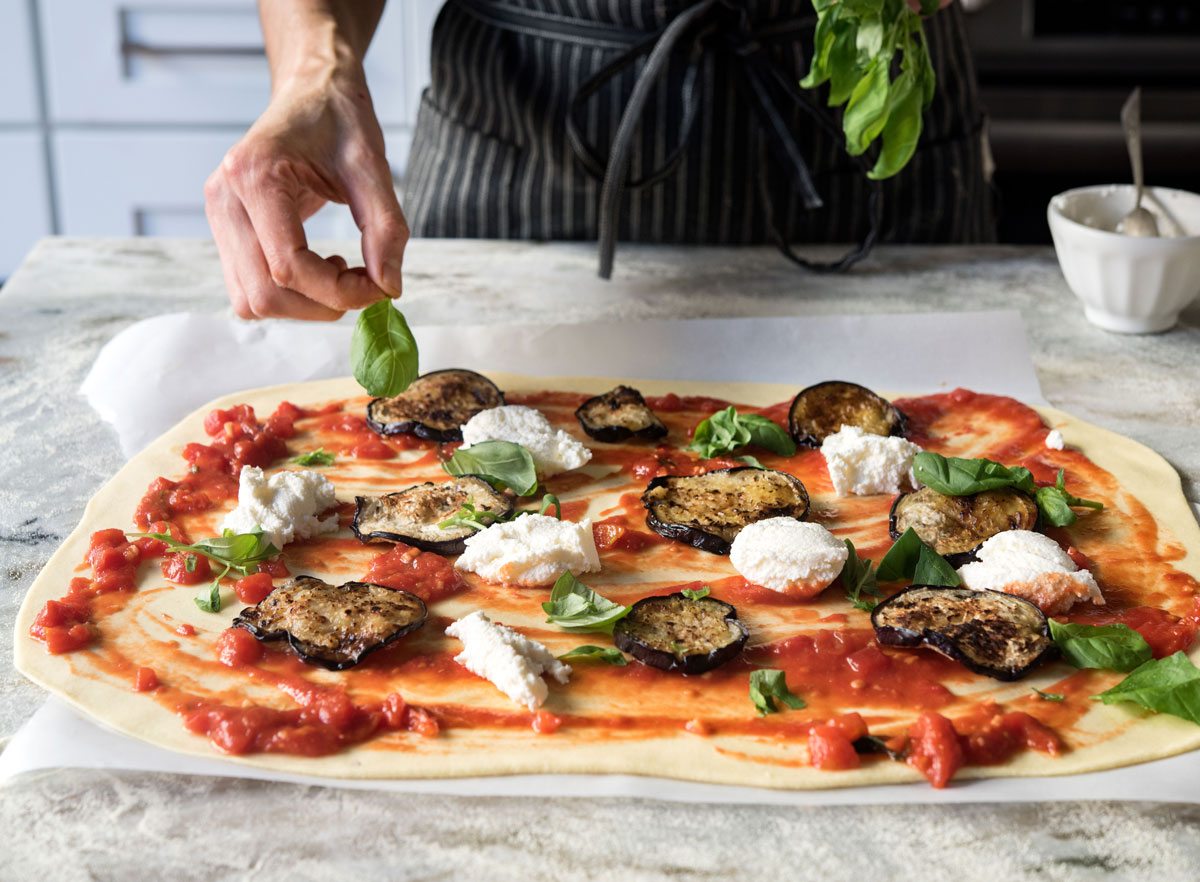
Assemble the Scaccia:
- Preheat your oven to its maximum temperature (typically 500°F/260°C) with a baking stone inside. Allow it to heat for at least 1 hour.
- Divide the dough into two pieces. Keep one wrapped in plastic while you work with the other.
- Lightly dust your work surface with semolina flour. Roll out the dough into a large, thin rectangle. (Tip: Roll on parchment paper for easier handling.)
- Spread a thin layer of tomato sauce over the surface, then layer with your chosen filling:
- For Filling #1: Add caciocavallo or pecorino slices and fresh basil.
- For Filling #2: Add pan-fried eggplant, dollops of ricotta, grated Parmesan, and basil.
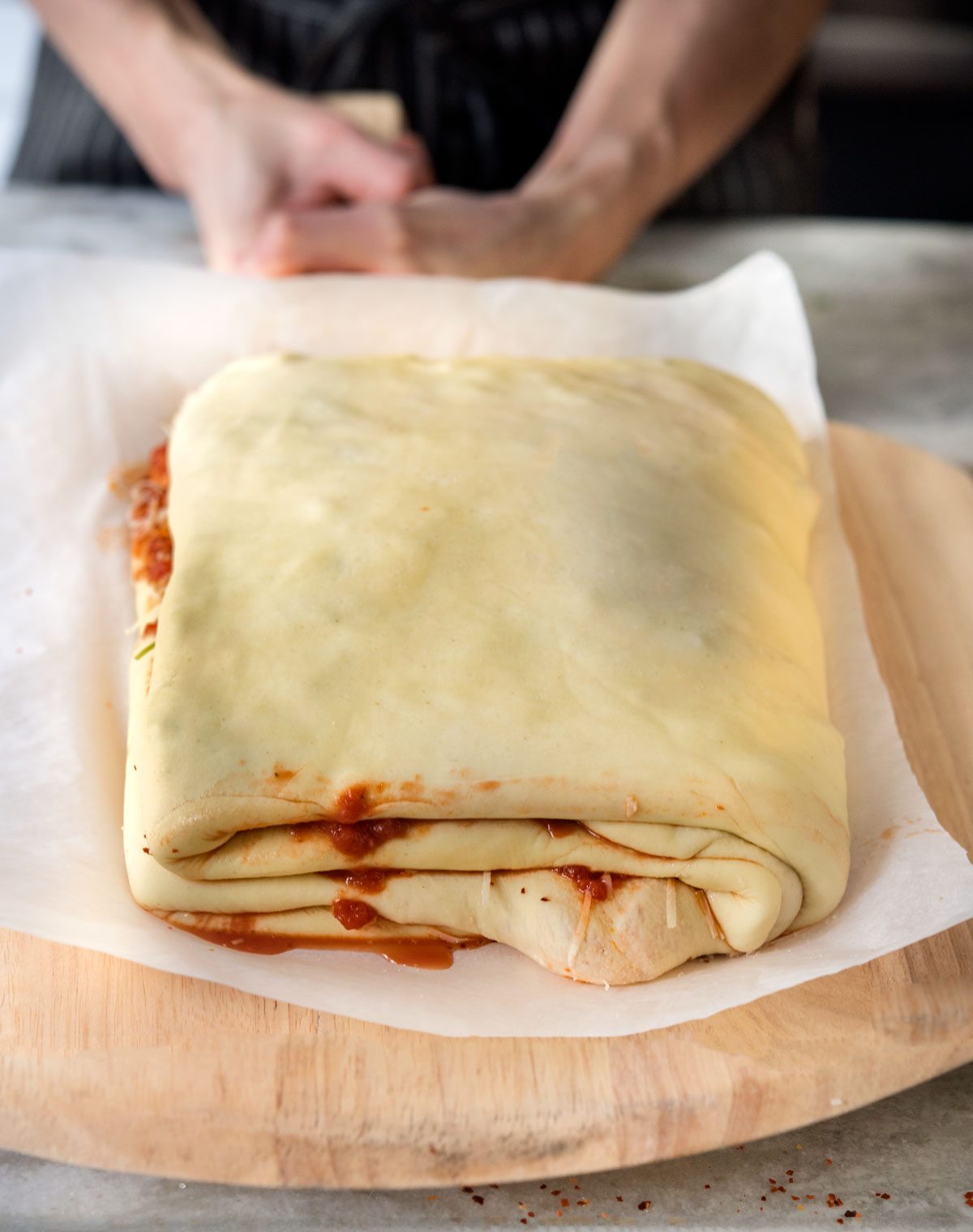
Fold and Layer:
- Fold the dough lengthwise so the sides meet in the middle.
- Add another thin layer of sauce, filling, and basil.
- Fold the top and bottom ends in so they meet in the middle. Add more sauce and filling.
- Finally, fold the dough in half like a book, creating multiple layers.
- Brush the top lightly with olive oil. Repeat with the second dough portion.
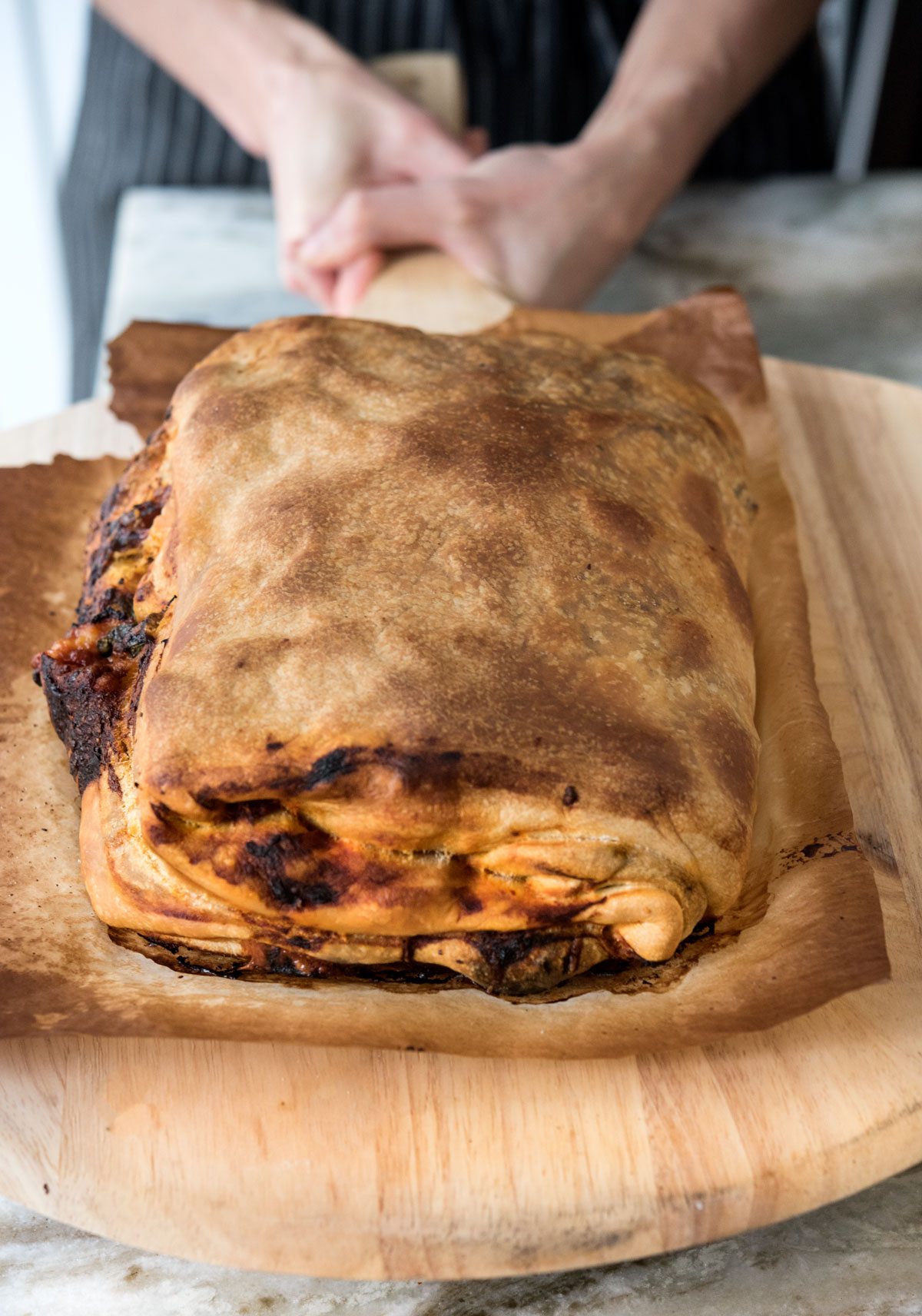
Bake:
- Use a pizza peel to transfer the scaccia (with parchment paper) onto the hot stone.
- Bake at maximum heat for 10 minutes.
- Lower the oven temperature to 400°F (200°C) and bake for an additional 60-70 minutes until crispy and golden brown.

101 Guide to Succeeding with Scaccia Ragusana:
- Durum Semolina Flour: This flour gives the dough its signature elasticity and flavor. Don’t substitute with regular flour, as it will alter the texture.
- Anchovies in Sauce: Even if you’re hesitant about anchovies, they dissolve into the sauce, adding a depth of umami without a fishy taste.
- Thin Layers: Roll the dough as thin as possible for the traditional layered texture.
- Filling Variations: Try experimenting with sautéed mushrooms, zucchini, or a different cheese.
- Hot Stone Advantage: A hot baking stone ensures a crispy bottom crust. Preheating is essential.
- Cutting the Scaccia: Let the baked bread rest for 5-10 minutes before slicing to allow the layers to set.
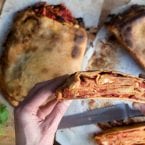
Lasagna Bread: Scaccia Ragusana
- Total Time: 2 hours 20 minutes
- Yield: 2 Loaves 1x
Description
Scaccia Ragusana, Sicilian lasagna bread, is a delicious combination of thin semolina dough, savory fillings, and a wonderful tomato sauce. It looks great, and it tastes amazing.
Ingredients
Dough:
- 3 cups (500 g) durum semolina flour
- 1 tsp salt
- 2 tbsp olive oil (plus extra for brushing)
- 1 cup (240 ml) water
Tomato Sauce:
- 1 tbsp olive oil
- 3 to 4 salt-cured anchovies, jarred or canned, in olive oil
- 3 to 5 cloves garlic, minced
- Pinch red pepper flakes
- 42 oz (1.2 kg) crushed canned tomatoes
- Salt to taste
- Handful of fresh basil leaves
Filling #1:
- 1/2 bunch fresh basil
- 1/2 lb (225 g) thinly sliced caciocavallo or pecorino cheese
Filling #2:
- 1/2 bunch fresh basil
- 1 small eggplant, sliced and pan-fried in olive oil
- 1 cup (240 g) fresh ricotta cheese
- Grated Parmesan cheese
Instructions
Prepare the Tomato Sauce:
- Heat 1 tbsp olive oil in a saucepan over medium heat.
- Add the anchovies, breaking them up with a wooden spoon until dissolved.
- Stir in the minced garlic and a pinch of red pepper flakes, sautéing for about 1 minute.
- Add the crushed tomatoes, season with salt, and toss in a handful of torn basil leaves.
- Bring the mixture to a boil, reduce the heat, and simmer for 10-15 minutes until the sauce thickens. Taste and adjust seasoning as needed.
Make the Dough:
- In a large bowl, combine the semolina flour and salt.
- Drizzle in 2 tbsp olive oil, then slowly mix in the water.
- Knead the dough on a floured surface for 5-7 minutes until smooth and elastic.
- Cover with plastic wrap and let rest for 30 minutes.
Assemble the Scaccia:
- Preheat your oven to its maximum temperature (typically 500°F/260°C) with a baking stone inside. Allow it to heat for at least 1 hour.
- Divide the dough into two pieces. Keep one wrapped in plastic while you work with the other.
- Lightly dust your work surface with semolina flour. Roll out the dough into a large, thin rectangle. (Tip: Roll on parchment paper for easier handling.)
- Spread a thin layer of tomato sauce over the surface, then layer with your chosen filling:
- For Filling #1: Add caciocavallo or pecorino slices and fresh basil.
- For Filling #2: Add pan-fried eggplant, dollops of ricotta, grated Parmesan, and basil.
Fold and Layer:
- Fold the dough lengthwise so the sides meet in the middle.
- Add another thin layer of sauce, filling, and basil.
- Fold the top and bottom ends in so they meet in the middle. Add more sauce and filling.
- Finally, fold the dough in half like a book, creating multiple layers.
- Brush the top lightly with olive oil. Repeat with the second dough portion.
Bake:
- Use a pizza peel to transfer the scaccia (with parchment paper) onto the hot stone.
- Bake at maximum heat for 10 minutes.
- Lower the oven temperature to 400°F (200°C) and bake for an additional 60-70 minutes until crispy and golden brown.
Notes
Durum Semolina Flour: This flour gives the dough its signature elasticity and flavor. Don’t substitute with regular flour, as it will alter the texture.
Anchovies in Sauce: Even if you’re hesitant about anchovies, they dissolve into the sauce, adding a depth of umami without a fishy taste.
Thin Layers: Roll the dough as thin as possible for the traditional layered texture.
Filling Variations: Try experimenting with sautéed mushrooms, zucchini, or a different cheese.
Hot Stone Advantage: A hot baking stone ensures a crispy bottom crust. Preheating is essential.
Cutting the Scaccia: Let the baked bread rest for 5-10 minutes before slicing to allow the layers to set.
- Prep Time: 60 mins
- Cook Time: 80 mins
- Category: Baking
- Method: Baking
- Cuisine: Italian
Nutrition
- Serving Size: 1 slice
- Calories: 280
- Sugar: 3g
- Sodium: 360mg
- Fat: 12g
- Saturated Fat: 6g
- Unsaturated Fat: 4g
- Trans Fat: 0g
- Carbohydrates: 32g
- Fiber: 2g
- Protein: 8g
- Cholesterol: 25mg













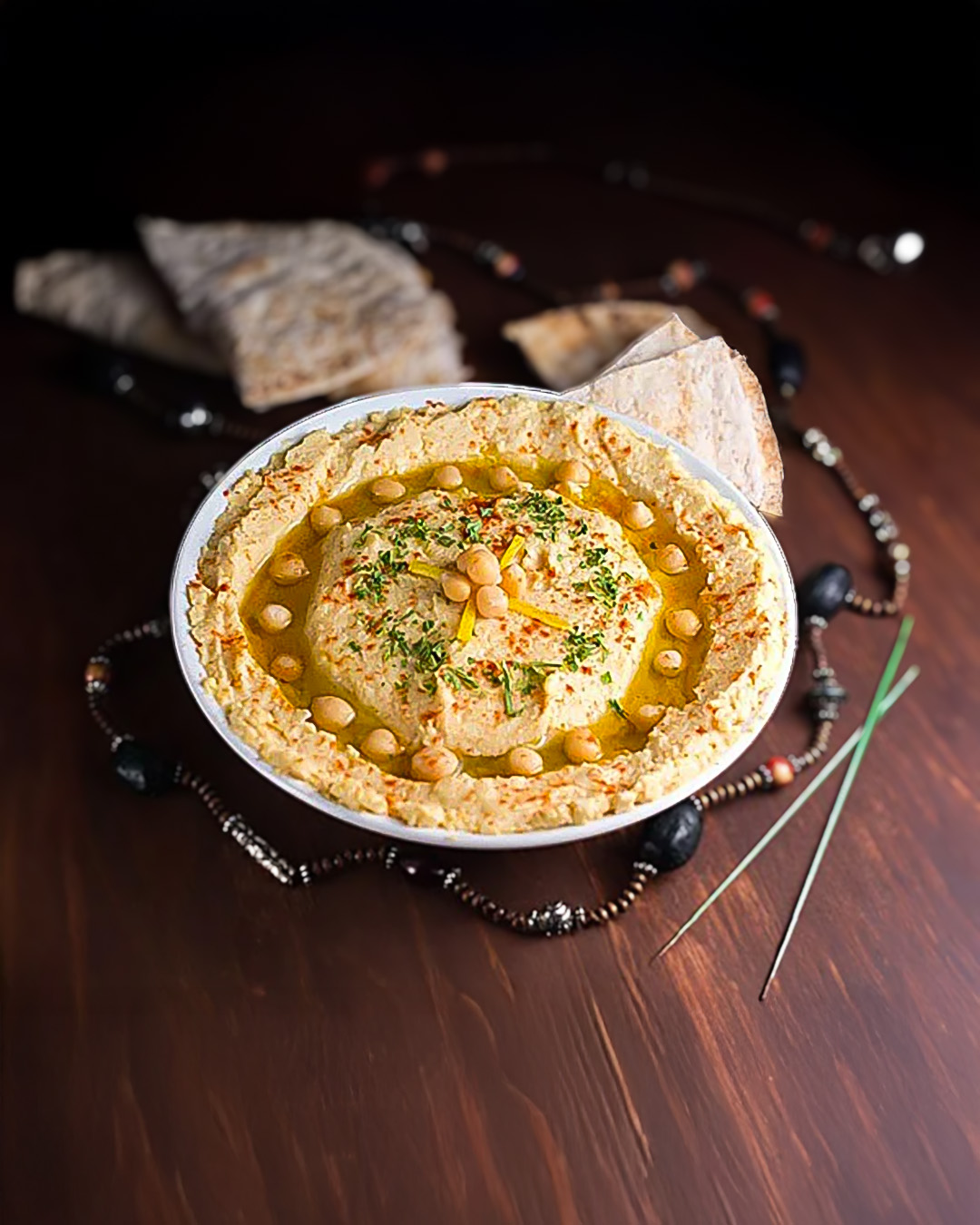

Wow, this is a fantastic recipe, I had no idea this existed but it is amazing!
Our grandmother was from Ragusa, Sicily and we’ve been eating and making this at Easter for years. The only part of the recipe we couldn’t figure out was the dough and the folding. We wanted it to look like our grandmothers but it never did. Finally we found a recipe like this and realized; no yeast in the dough and instructions on how to fold. Thank you for publishing this for those of us who are trying to keep the tradition going and for the variations on the filling. Any idea of other Easter pies from Ragusa? We make a ricotta with onions, a broccoli with pig skin-hot pepper flakes -garlic.
I am making this on Saturday. Can’t wait! I make croissants and other pastries and pizza dough so this is just going to be delicious! Thank you for sharing.
Name of the recipe is difficult but the recipe is really exquisite.You explained each and every important thing regarding recipe beautifully. I am looking forward to make this by myself.